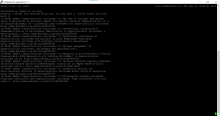The initial build out of the new Toolforge jobs framework has been deployed.
We move into the BETA phase, where we expect to:
- collect feedback from beta testers
- identify & correct flaws in the design
- identify & correct general bugs
- add new or missing features that may be interesting to the community
See live documentation at https://wikitech.wikimedia.org/wiki/Help:Toolforge/Jobs_framework
How to operate with the framework in this beta stage:
$ ssh dev-buster.toolforge.org $ become $mytool $ toolforge-jobs containers Short name Docker container image ------------- ---------------------------------------------------------------------- tf-buster-std docker-registry.tools.wmflabs.org/toolforge-buster-standalone:latest tf-golang111 docker-registry.tools.wmflabs.org/toolforge-golang111-sssd-base:latest tf-jdk11 docker-registry.tools.wmflabs.org/toolforge-jdk11-sssd-base:latest tf-node10 docker-registry.tools.wmflabs.org/toolforge-node10-sssd-base:latest tf-php73 docker-registry.tools.wmflabs.org/toolforge-php73-sssd-base:latest tf-python37 docker-registry.tools.wmflabs.org/toolforge-python37-sssd-base:latest tf-ruby25 docker-registry.tools.wmflabs.org/toolforge-ruby25-sssd-base:latest tf-tcl86 docker-registry.tools.wmflabs.org/toolforge-tcl86-sssd-base:latest wm-buster docker-registry.tools.wmflabs.org/wikimedia-buster:latest wm-stretch docker-registry.tools.wmflabs.org/wikimedia-stretch:latest [..] $ # running a normal job: $ toolforge-jobs run myjob --command ./mycommand.sh --image tf-buster-sd $ # running a normal job and waiting for it to complete: $ toolforge-jobs run myotherjob --command ./myothercommand.sh --image tf-buster-sd --wait $ # running a continuous job: $ toolforge-jobs run myalwaysrunningjob --command ./myendlesscommand.sh --image tf-buster-sd --continuous $ # running a scheduled job: $ toolforge-jobs run myscheduledjob --command ./everyminute.sh --image tf-buster-sd --schedule "1 * * * *" $ toolforge-jobs list Job name: Command: Job type: Container: Status: -------------- ----------------------- ------------------- ------------- --------------------------- myscheduledjob ./read-dumps.sh schedule: * * * * * tf-buster-std Last schedule time: 2021-06-30T10:26:00Z alwaysrunning ./myendlesscommand.sh continuous tf-buster-std Running myjob ./mycommand.sh normla tf-buster-std Completed $ toolforge-jobs show myscheduledjob +------------+-----------------------------------------------------------------+ | Job name: | myscheduledjob | +------------+-----------------------------------------------------------------+ | Command: | ./read-dumps.sh | +------------+-----------------------------------------------------------------+ | Job type: | schedule: * * * * * | +------------+-----------------------------------------------------------------+ | Container: | tf-buster-std | +------------+-----------------------------------------------------------------+ | Status: | Last schedule time: 2021-06-30T10:26:00Z | +------------+-----------------------------------------------------------------+ | Hints: | Last run at 2021-06-30T10:26:08Z. Pod in 'Pending' phase. State | | | 'waiting' for reason 'ContainerCreating'. | +------------+-----------------------------------------------------------------+ $ toolforge-jobs delete myscheduledjob $ toolforge-jobs flush $ toolforge-jobs list [.. nothing ..]
